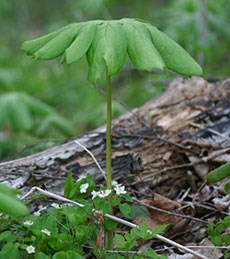
IntroductionFound in spring, this plant of the rich, black, moist soils of the deciduous forest is a common sight as it stands singly, or more often in large stands. It will grow to about 18-20 inches tall and usually has two large, umbrella-shaped leaves under which grows a single, white, waxy flower. The fruit, which is 1-2 inches in size, is a pale golden yellow and appears by late spring or early summer. All parts of this plant are quite poisonous with the exception of the ripe fruit which some claim may be eaten in jellies; others claim the fruit is mildly toxic and when eaten should not be consumed in large quantities. Wildlife avoid eating this plant. As with any wild fruit, it is best not to sample unless you are sure of the plant's identification and that you know the fruit is ripe. Mayapples become dormant and disappear after fruiting and become difficult to find in late summer. They are, however, perennials and will appear in the same places each spring. Blooms: May and early June. Fascinating Facts
Find ItWant to Help Us Better Understand the Park?See our iNaturalist project, "The Life of the Mississippi National River and Recreation Area" and contribute to it by downloading the iNaturalist app and uploading your sightings of this species, and others, to the project. You can also upload your sightings from your computer. |
Last updated: March 7, 2018
